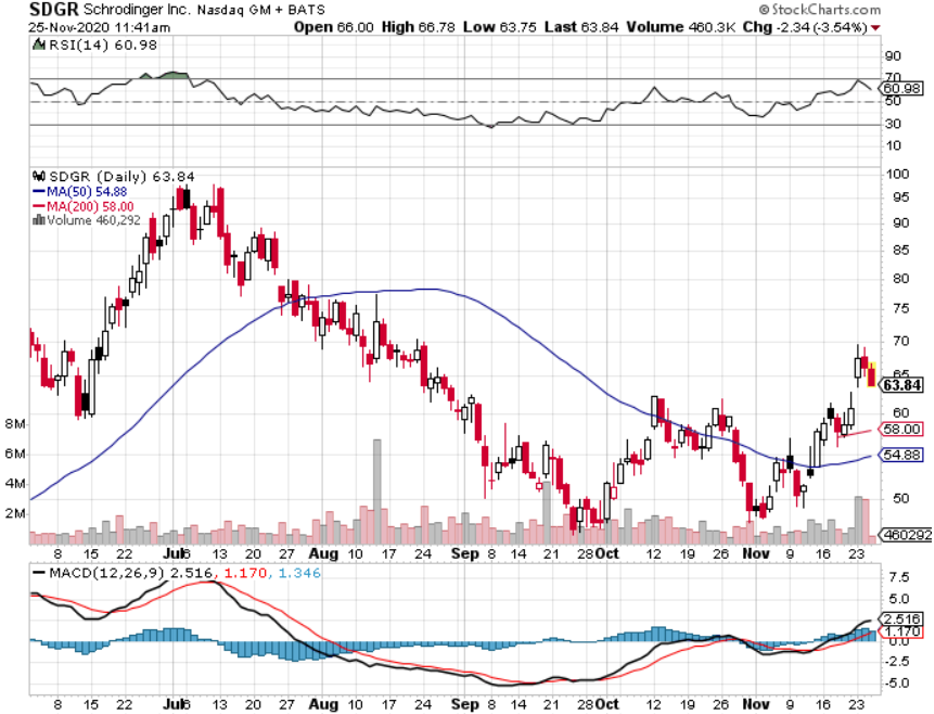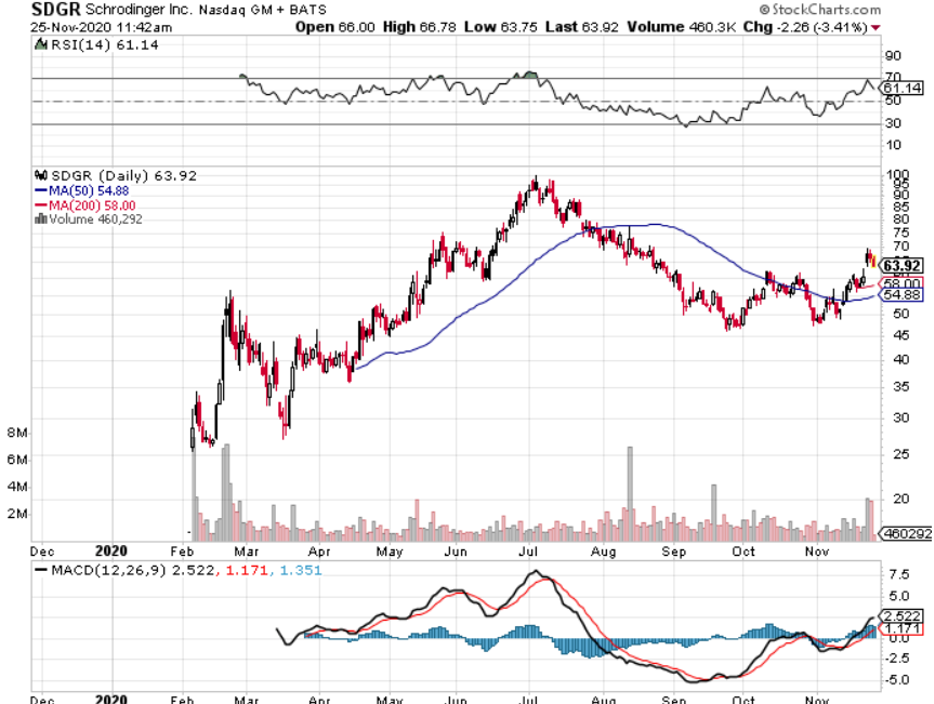For those speculative tech investors, I have an early-stage tech company that could be of interest to you.
This one is a big loss-maker just like in the mold of most growth companies, but they have the stereotypical revenue growth trajectory that is prevalent in strong tech stocks.
It might be a while before this one turns a meaningful profit but this company also sits at the intersection of healthcare and software cloud computing which is an ideal place to be in the 2020s.
Investors who can absorb higher risk and volatile price action should take a flyer on Schrödinger, Inc. (SDGR) who provides a computational platform to accelerate drug discovery and materials design for biopharmaceutical and industrial companies, academic institutions, and government laboratories worldwide.
Their most recent earnings reports offer us a brief snapshot of this burgeoning software company with software revenue underpinning top line of $22.9 million, an increase of 42% compared to the third quarter last year.
Schrödinger continues to see deeper engagement within the platform by customers, leading to robust year-over-year growth in software revenue.
They also have a talented team of scientists and software developers that continue to make significant progress in advancing the science that undergirds the computational platform.
Schrödinger recently published several papers describing advances in FEP+, including improved methods for accurately modeling binding affinities in metalloenzyme inhibitors, improved support of macrocycle design and optimization, and improved approaches to optimizing binding selectivity, which is a major way of reducing potential toxicity of drug molecules.
Schrödinger also adopted active learning workflow for structure-based hit discovery, which can screen massive libraries of compounds with greatly improved computational efficiency.
The firm has seen new drug candidates discovered in their collaborative programs progress into IND-enabling and first-in-human studies.
I believe these advancing programs represent examples of the impact of Schrödinger’s physics-based methods, not just in achieving broad exploration of chemical space, but more importantly, on the optimization of high quality development candidates, with balanced properties for clinical testing.
As an example, Morphic's MORF-057 for inflammatory bowel disease, which initiated a clinical trial in the third quarter, is one of several examples where Schrodinger Technology-enabled solutions to their health partner's preclinical design challenges.
In this case, the design of selective compounds for the integrin alpha 4 beta 7 was enabled by an important advancement to properly treat the receptor's metal centers.
Schrödinger recently reported a significant increase in the number of collaborative programs that had reached the latest stages of drug discovery.
I expect to see many of the collaboration programs and lead optimization into preclinical development over the next year.
What about the internal pipeline?
Schrödinger launched five oncology programs targeting solid tumors and hematological malignancies.
The preclinical data packages assembled to date include mechanistic validation and anti-tumor activity data.
I believe, based on the data generated to date, that each of these assets could have monotherapy activity in specific populations, as well as utility, in combination with other approved and late-stage oncology products.
Looking forward, Schrödinger has also prioritized several new program opportunities, with genetic support in human cohorts and emerging pharmacology data, in oncology and immunology.
In addition to strategic hires in preclinical and early clinical development, they have also expanded the drug discovery team, adding key seasoned immunology expertise.
All of this translates into a meaningful rise in software revenue because of the increased adoption of solutions by large customers, as well as the addition of new customers.
Schrödinger continues to experience strong uptake in live design, and their enterprise solution for drug discovery.
Live design integrates discovery workflows and can be especially powerful in fully remote work environments that many of us are still experiencing.
Software gross margin was 81% this quarter, unchanged from the third quarter of 2019.
Schrödinger’s business model has not been impacted by the health pandemic, and neither is its future runway of potential revenue.
The only drag from the pandemic is on the drug discovery side, it could cause temporary delays in some programs. In any case, I do not envision a long-term impact from the public health situation on Schrödinger’s ability to execute and deliver on its strategy.
In summary, Schrödinger’s outperformance stems from its brilliant execution across its array of businesses, resulting in strong revenue growth, increasing collaboration equity value, progress in internal and collaboration programs, continued scientific advancement of in-house technology, and the successful IPO and follow-on financings that strengthen their balance sheet and provide strategic optionality.
Annual revenue still is under an annual run-rate of $100 million and as software revenue growth still displays robust plus-40% growth rates and a juicy gross margin of 81%, it’s only a matter of time before institutional investors start deploying capital in this up-and-coming tech name.



